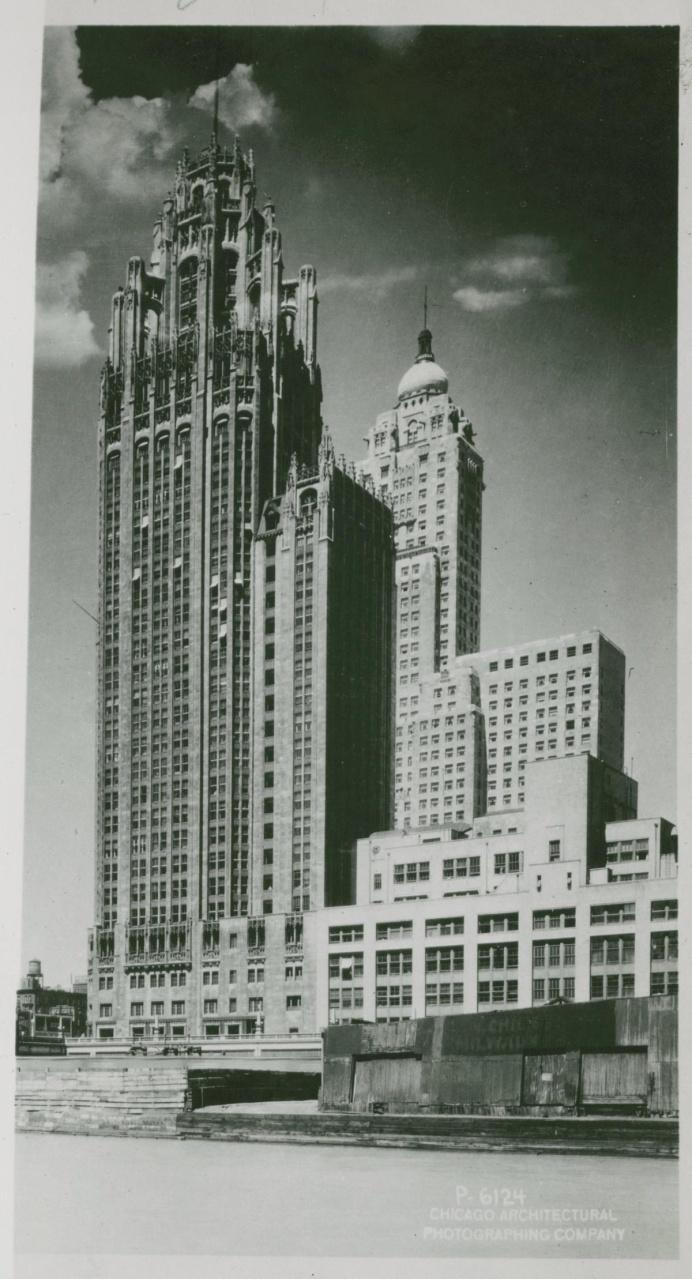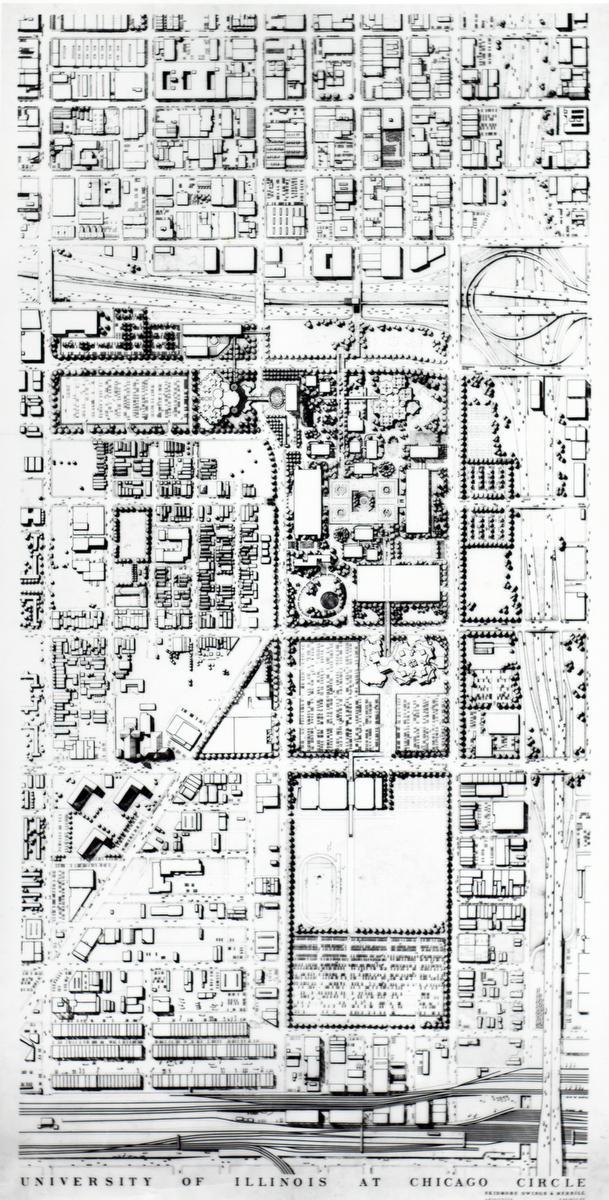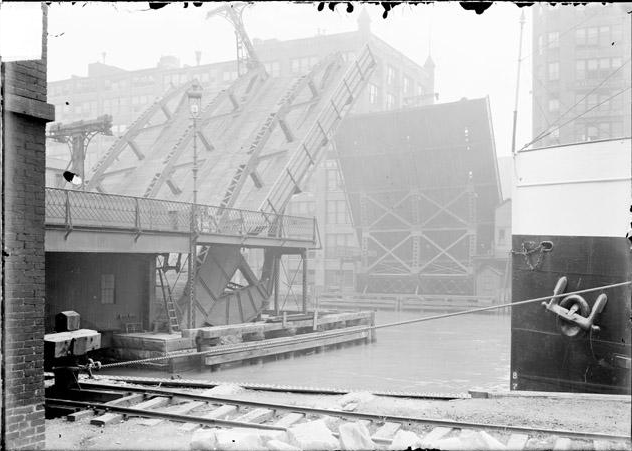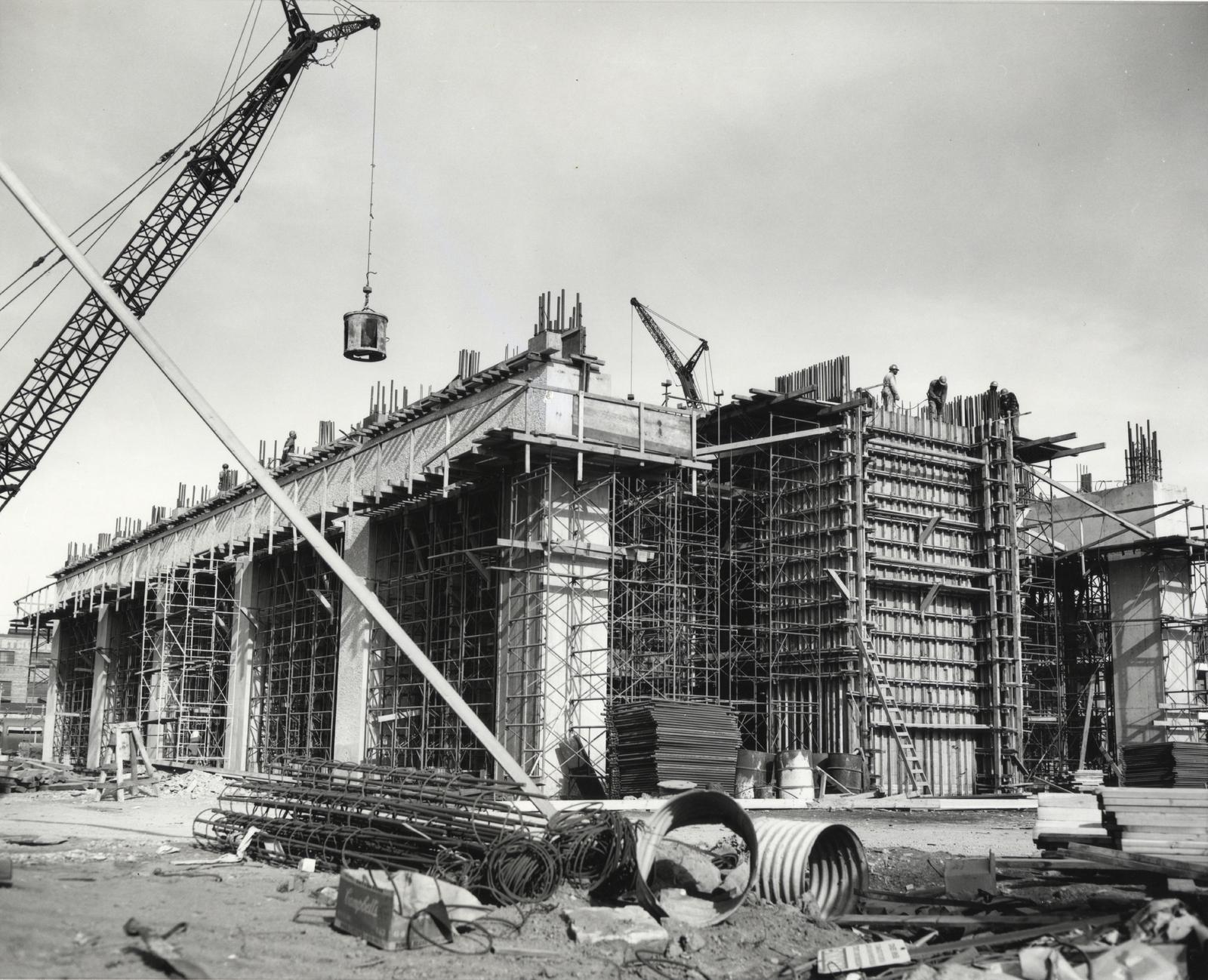The Chicago School represents the first developments in skyscraper architecture in the United States. This movement was driven by individual efforts of architects and engineers, including Louis Sullivan and Dankmar Adler. In 1889 they built an outstanding Chicago Auditorium building that is a perfect example of the Chicago school (Craven, “What is the Chicago School?”). However, their success was partly predetermined by a disastrous Chicago fire of 1871 and advancements of the Industrial Revolution.
Unpredictable dreadful events such as conflagrations have the power to change the way people organize living space. It is believed that the fire started in the barn belonging to Patrick and Catherine O’Leary and spread quickly over the wooden-built houses (Smith, p. 19). It profoundly impacted the residential area destroying the homes of nearly 100,000 Chicagoans (Smith, p. 22). As a result, engineers realized the need to construct fire-proof buildings and use the available land efficiently. Moreover, Chicago was the center of the innovative solutions spurred by the Industrial revolution. The Pullman sleeping car, mail-order retailing, and the invention of the elevator were the prerequisites for the new architectural style (“Architecture: The First Chicago School”).
The Auditorium is a unique landmark of the city that depicts the talents and courage of Sullivan and Adler. They managed to develop a solution based on the usage of timber and steel beams for the marshy ground (“Architecture: The First Chicago School”). Moreover, due to the effects of the fire, the Chicago school started to prioritize the metal skeleton frame. This decision led to further construction of skyscrapers and bridges all across the country.
Historical Significance
The emergence of the school is a significant event in the history of Chicago as it marks the rebirth of the architecture. First of all, the figure of Louise Sullivan deserves special attention. He wanted to introduce and promote new traditions in this architectural style by famously stating that “form follows function” (Craven, “About Louis Sullivan, Architect.”). He underlined that the exterior of the building should be aligned with its internal purpose (Craven “About Louis Sullivan, Architect.”). The employment of ornamentation has to find encouragement in the nature of the site. However, the photo of the interior, with its elaborated design contrasts quite plain exterior façade. Sullivan inspired other architects like Frank Wright, William Holabird, and Martin Roche (Taylor).
In addition, the technical approach to acoustics and engineering demonstrated by Adler suggested original ways of functionality. Auditorium Theater could accommodate political gatherings, as well as opera and ballet performances. Sullivan believed in multiple functions of commercial buildings where retailers, business people, and artistic communities could co-exist. More and more architects started to experiments with style and functionality, which shaped the image of Chicago as a center of economic and cultural life.
The rapid urbanization continued after the famous World’s Columbian Exposition that took place in 1893. The fair allowed strengthening the progress Chicago made after the fire. Most importantly, the event led to the development of the residential South Side and the transportation infrastructure (“World’s Columbian Exposition of 1893”). The design of the exposition site offered a new vision for the flourishing city. The most notable achievement of the fair is Burnham and Edward H. Bennett’s 1909 plan of Chicago.
Annotated bibliography
“Architecture in the West.” The Inland Architect and News Record, vol. 13-14, 1889 – 1890, p. 80.
The article tells about various aspects of architecture in the West of the country. The author discusses the influence of the works of various architects on the overall appearance of the American architectural style. In the text the Auditorium Theater by Adler and Sullivan is referred to as the most scientifically constructed and perhaps the best appointed large hall in existence (“Architecture in the West”, 80). The author also draws the reader’s attention to the fact that the architecture may not be clear to everyone, but the work done definitely deserves attention because of its scale.
Birkmire, Wm. H. (William Harvey). The Planning and Construction of the American Theaters. New York: J. Wiley & Sons, 1896, p. 8.
In this book, various examples of the design of theatres are discussed in order to achieve their maximum fire resistance. As it known, this problem was topical for that time, and Adler and Sullivan managed to make a breakthrough in the construction of a safe buildings, the Auditorium Building in particular. The book also describes the performance properties of the Auditorium Theater. It mentions that the theater is the greatest for mass concerts and opera, but not well adapted for dramatic performances (on account of the great distance from the stage to the farthest seats).
Flinn, John Joseph. Chicago, the Marvelous City of the West; a History, an Encyclopedia, and a Guide. Chicago, Flinn and Sheppard, 1891, pp. 135-138.
The book is a kind of integration of a collection of encyclopedic articles, guide, and a historical note. It was written as an informative brochure for visitors in order to attract them to visit the most famous and beautiful places in the city. It is obvious that for the author, not only the appearance, but also the internal content of architectural monuments is essential. The Auditorium Building is described here as the most famous building on the American continent (Flinn 134). There is also a detailed description of its purpose, exterior and interior decoration, and creation history. Special attention is paid to fire resistance since this was the determining factor for new buildings after the Chicago fire.
“Illinois State Association of Architects.” The Inland Architect and News Record, vol. 13-14, 1889 – 1890, pp. 38-39.
This source contains a list of articles and news about the architecture of Chicago. What is interesting in this particular publication, it is described how Dankmar Adler himself reports on the mechanism of the stage chosen in the Auditorium theater and on the latest achievements in this field in theaters of Europe (“Illinois State Association of Architects”, 38). Among other things, the improvements made in connection with the Chicago fire of 1871 are mentioned (“Illinois State Association of Architects”, p. 39).
Lord, Chester Arthur. Foundations for tall buildings. Bachelor of Science Degree Thesis, University of Illinois. The Illinois Digital Environment for Access to Learning and Scholarship, 1910.
In 1910, Chester Arthur Lord wrote a thesis for the degree of Bachelor of Science in Civil Engineering. He notes soil characteristics on building construction sites in New York and Chicago and connects them to the features of foundation engineering. Specifically, in respect of the Auditorium Building, he studies its structural features associated with weight and total area. Although this reference does not have a special historical or cultural value, it sheds light on the technical features of construction at those times.
Picturesque Chicago and Guide to the World’s Fair. Lennox Pub. Co., 1893.
This book is a guide to the city of Chicago, presenting its most significant, famous and exciting places in 1893. Surely, the Auditorium Building got on its pages. The building is described as the embodiment of the modern idea, as the Coliseum at Rome represented the ancient (“Picturesque Chicago and Guide to the World’s Fair”, 43). In addition to the description of the building itself, the guide tells about the theater and a great high-class hotel located inside. On the pages, photos of the interior decoration of the rooms can be found, which gives an idea of the appearance of the hotel at that time.
Shapiro, Benjamin. Tall Buildings of Chicago and New York. Bachelor of Science Degree Thesis, University of Illinois. The Illinois Digital Environment for Access to Learning and Scholarship, 1910.
In 1910, Benjamin Shapiro wrote a thesis for the degree of Bachelor of Science in Civil Engineering. The thesis provides the reader with basic introductory information about high-rise buildings in New York and Chicago, including the Auditorium Building. In comparison with the work of Lord, C.A., the information provided here reflects the location, construction dates, and purpose of the building. Also, information about the total cost and technical characteristics can be found. This work allows conducting a comparative analysis between high-rise buildings of the late 19th century.
“Auditorium Building.” Empori.
This web page provides fairly detailed information about the location, type, construction materials, and technical characteristics of the Auditorium Building. Also, on the page, there is a photo gallery that allows giving a complete picture of the appearance of the building. In addition, there is a list of interesting historical facts about the building’s operation, which are presented in an easily accessible form.
Condello, Annette. The Architecture of Luxury. Routledge, 2016.
In this book, the author examines the aspect of the level of social assessment of the Auditorium Building. The hotel located in the building is rated as a new standard of luxury, created directly by Louis Sullivan. Both the internal content of the hotel and the external decoration of the building is considered. The fact of fire resistance is also mentioned as a great advantage, which is natural after the Chicago fire.
Elstein, Rochelle B. Dankmar Adler: A Biography. 2017. By Arthur S. Elstein.
In the biography of Dankmar Adler, a separate chapter is dedicated to the history of the Auditorium Building’s creation. The fact of its innovation and complexity of construction is noted. It is obvious that the building had an important role in the life of the architect and engineer, as references to it can be found in almost every chapter of the book. The concept and context in which the building was created are examined, as well as its social message.
Horstmannshoff, Kai. “The Cathedral of Nature: Sullivan’s and Adler’s Auditorium Building and the Narrative Function of Architecture.” Zeitschrift für Anglistik und Amerikanistik. 2016.
In this essay, the author considers the construction of the Auditorium Building as a narrative, which means a sequence of distinctive features and events associated with the construction and existence of the architectural structure. The author directly links visual images with spiritual values (section 3, paragraph 2). This essay allows evaluating the architectural and cultural value of the Auditorium Building, as well as to give an idea of the institution of society contemporary for it.
Pridmore, Jay, and George A. Larson. Chicago Architecture and Design. Abrams, 2018.
The author describes in detail the history of the Auditorium Building and the various prerequisites that led to a particular architectural image. The theater component, sources of inspiration for its creation, and technical features are notably highlighted. Interestingly, the author pays more attention to the interior of the building than to its external appearance. The significance of the building for the further development of Chicago architecture is also defined.
Weingarden, Lauren S. Louis H. Sullivan and a 19th-Century Poetics of Naturalized Architecture. Routledge, 2017.
The author examines the historical and cultural position of Louis Sullivan and connects it with the structural forms and ornaments that he used in his work. It is noted that architecture and construction for Sullivan were equal to the spiritual functions of poetry and landscape (243). As for the Auditorium Building, its concept is being studied, as well as two different decorative systems within which it was created.
Works Cited
- “Architecture: The First Chicago School.” Encyclopedia of Chicago, Web.
- “Auditorium Building (interior).” Encyclopedia of Chicago, Web.
- Craven, Jackie. “About Louis Sullivan, Architect.” ThoughtCo, Web.
- Craven, Jackie. “What is the Chicago School?” ThoughtCo, Web.
- Smith, Carl. Urban Disorder and the Shape of Belief. The University of Chicago Press, 1995.
- “World’s Columbian Exposition of 1893.” Chicago Architecture Center, Web.
- Chicago, 1930s, 1930-1940, Newberry Library, Chicago Architectural Photography Company.
- Auditorium Theater, View Looking from the Back of the Theater Over the Rows of Seats on the Main Floor Toward the Curtained Stage, 1909, Chicago History Museum, Chicago Daily News, Inc., photographer.
- Jack Knife Bridge in Raised Position Over the Chicago River, Dark Exposure, ca. 1902, Chicago Historical Society, Chicago Daily News, Inc., photographer. Web.
- Skidmore, Owings and Merrill, and Walter Netsch. Map of Campus and the Neighborhood, 1969, University of Illinois at Chicago Circle. Web.
- Skidmore, Owings and Merrill, and Walter Netsch, University Hall construction, 1963 Nov.-Dec., 1963, University of Illinois at Chicago. Web
Image gallery

Tribune Tower, which was designed in the 1920s by John Mead Howells and Raymond Hood, is one of the clear examples of works of the first Chicago School of architecture known for being a pioneer in the development of skyscrapers. Architects chose the neo-Gothic style as a dominant, which is typical for the Chicago School of Architecture. The construction of such buildings marked the beginning of the industrial era in the United States. The need for new technologies was conditional upon the previous experience of architects related to the destruction of the city by Chicago fire of 1871. It also reflected the need for a new approach towards the living space people use. Therefore, the buildings were planned to be functional and safe for people. The idea of usefulness and safety was further developed by other architects and shaped the city one can see today.

The map of campus and the neighborhood of the University of Illinois at Chicago Circle was made by architects Owings and Merrill Skidmore in 1969. The construction plan of the campus contributes to the idea of the external simplicity of the buildings. This concept was popular among the architects and engineers of the first Chicago School of architecture. It was conditional upon the need for functionality in the future buildings. As a rule, all the decorations and ornamentations of these buildings were inside the rooms, not on the facades. The same applies to this campus plan, which is defined by straight lines and functional location of all the necessary premises.

The inventions of the first Chicago School of architecture were not limited to the construction of skyscrapers. The use of metal skeleton frames also contributed to the development of the construction of bridges in the city. Thus, for example, the Jack Knife Bridge, designed at the beginning of the 20th century by William Scherzer, appeared due to the emergence of such technologies. The bridges of Chicago changed transportation and, therefore, the economic life of the city and became architectural masterpieces of that time. Their construction was one of the best solutions for a city by the river and became the new sphere of architecture for the country.

The building of the Auditorium Theater is one of the best examples of the ideology of the first Chicago School of architecture. The collaboration of engineers and architects allowed them to present the idea of external simplicity with internal functionality and ornamentations with the help of innovative materials. This type of building also contains the metal skeleton frame, which is the best solution in terms of safety and prevention of fire. Auditorium Theater, which was designed at the end of the 19th century by Dankmar Adler, is vital for architecture as it served as an example for other architects of the Chicago School. Its creation was followed by the construction of numerous buildings with the use of similar technologies.

The construction of University Hall, which was designed in the 1960s by Walter Netsch, contributed to the creation of Chicago’s image as a center of economic and cultural life. The buildings of that time were mainly intended for specific purposes, and they clearly reflected the idea of functionality above all. In the case of University Hall, the technologies were the same as the ones used for Tribune Tower or Auditorium Theater, despite the difference in their intended use. Thus, the functionality was combined with such elements as metal skeleton frames and the solution made of timber and steel beams. All these features made University Hall an excellent example of the first buildings of modern type in Chicago.